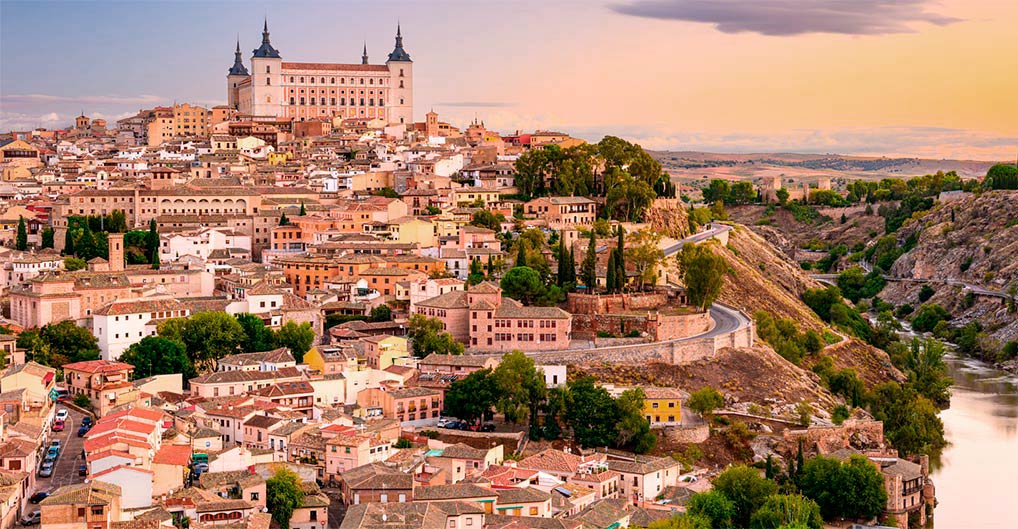STAMS 2023 / SEMTA-MECAMAT COLLOQUIUM. 4 - 6 October. Toledo, Spain
STAMS 2023 / SEMTA-MECAMAT COLLOQUIUM.
4 - 6 October. Toledo, Spain
MECHANICS ACROSS THE SCALES
Named a World Heritage Site by Unesco in 1986, Toledo is an outstanding museum city whose rich heritage owes almost everything to the Jews, Muslims and Christians who lived there, working and observing their religion side by side.
Each and every one of the cultures and peoples who’ve passed through Toledo gave the city a present made up of a rich architectural and artistic heritage. The city walls, erected during the Roman era, were reconstructed and given their current appearance by the Arabs. Many gateways mark the route of the walls, but Puerta de la Bisagra, which leads into the historic town and bears the coat of arms of the Imperial City, is the only one to have kept its Medieval architecture.

Cristo de la Luz Mosque (tenth century)
It’s the only surviving mosque of its style from the nearly ten that originally existed in the city. It can be found just after going through Puerta de la Bisagra. The horseshoe arches extend in a way reminiscent of the Grand Mosque in Córdoba.
El Tránsito Synagogue (fourteenth century)
The façade and beautiful plastered walls hide an interior with a rectangular floor plan, crowned by a lovely coffered ceiling. At present, the synagogue houses the Sephardic Museum.
Cathedral
The Cathedral was built in the Gothic style between 1226 and 1493 on the site of a Visigothic church erected during the reign of King Reccared. The sacristy contains a valuable collection of paintings by El Greco, Luca Giordano, Van Dyck and Goya. The side chapels are works of art in themselves: Nuevos Reyes, Santiago, the choir stalls in the Renaissance style, the Mozarabic chapel, the chapter house, etc.
El Greco House Museum
Although El Greco never actually lived in this house, the museum accommodates paintings by the master from Crete, such as The Tears of Saint Peter or Christ and the Apostles.
Alcázar
Located in the upper part of town, the present-day Alcázar was a fortress under the Romans, becoming a fortified palace – the first with a square floor plan – in the Christian era. Under King Charles I of Spain, it underwent significant renovation work. Each of its façades boasts a different style and dates back to a different period: the east façade is Medieval; the west one, Renaissance; the north façade has a Plateresque design; and the south one is Churrigueresque. The Alcázar was destroyed during the French invasion and in the Spanish Civil War, to be rehabilitated later. Now it is home of the Army Museum and military facilities.
Church of Santo Tomé
Inside, it houses an artistic gem: “The Burial of the Count of Orgaz” by El Greco.
Mirador del Valle
This viewing point offers magnificent panoramic views of the river Tajo and the city’s monuments. In fact, painters such as El Greco and Picasso tried to capture its beauty.
San Martín Bridge
This bridge dates back originally to the mid-14th Century, although it was later rebuilt. It was declared a National Monument in 1921 and it offers an unbeatable spot to enjoy the setting sun of an evening.
Street map of Toledo’s historic quarter showing the locations of museums and monuments, prices and opening times, tourist services, useful telephone numbers, transport, etc.
https://turismo.toledo.es/downloads/descargas/114/english-map-of-toledo.pdf»
| 08:30-09:00 | Registration / Opening |
| 09:00-09:35 | Alan Needleman |
| 09:35-10:10 | Henryk Petryk |
| 10:10-10:45 | Ahmed Benallal |
| 10:45-11:15 | Coffee Break – Posters Session |
| 11:15-11:50 | Maurine Montagnat-Rentier |
| 11:50-12:25 | Alain Molinari |
| 12:25-13:40 | Lunch |
| 13:40-14:15 | Skander El Maï |
| 14:15-14:50 | Ankit Srivastava |
| 14:50-15:20 | Coffee Break – Posters Session |
| 15:20-15:55 | Jean-Baptiste Leblond |
| 15:55-16:30 | Samuel Forest |
| 16:30-17:05 | Carole Nadot-Martin |
| 19:30-22:00 | Welcome reception-Venta de Aires |